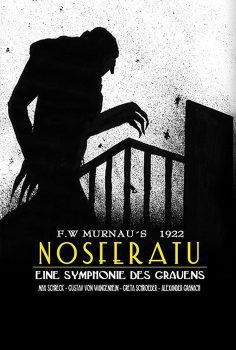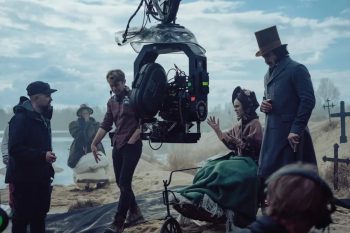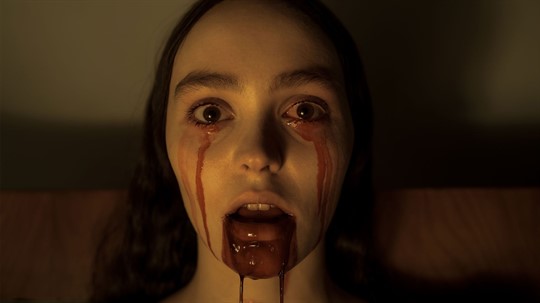by Eric Lindbom
-Taking its place alongside Fritz Lang’s METROPOLIS and several Buster Keaton full lengths, NOSFERATU: A SYMPHONY OF HORROR (1922) is among the most widely viewed silent features in existence, and we’re lucky to have it. This unauthorized German adaptation of Bram Stoker’s DRACULA was ordered destroyed (!) by a judge after Stoker’s widow won a lawsuit.
Director F.W. Murnau later brought us two of the grandest silent dramas ever (SUNRISE and THE LAST LAUGH). Still, horror fans revere Murnau for his third masterpiece, an eerie Expressionist take on DRACULA that makes a solid case as the definitive version. Murnau’s NOSFERATU has cast a lingering spell on legions of fans (and at least three filmmakers) for its evocative use of shadows and Murnau’s Count Orlok (a thinly disguised Drac) as a repugnant figure of pestilence with pointed ears and talons played by actor Max Schreck (his name translates as fright).

Among thos e caught in Murnau’s thrall was young Robert Eggers, who mounted a high school production and dreamt of mounting a cine adaptation for years. With his famed artisanal approach to period design, this seemed a match made in Heaven (or Hades), especially after Eggers’ superbly disquieting folk horror classic THE WITCH. Based on my adoration for it and all these things Eggers, including his haunting, divisive THE LIGHTHOUSE and the gonzo Icelandic action blood bath THE NORTH MAN, I approached his NOSFERATU with belfry high expectations further stoked by major pre-release hype.
Sometimes, be careful what you wish for. Alas, I’m taking a stake to the new NOSFERATU. Before saying why, I readily embrace the superb production design and Eggers’ eye for detail. All the stunning, snowy settings bring a cold weather shiver. He’s a world builder beyond compare, but so is Tim Burton, and he’s concocted several elaborate works I admire as eye candy but won’t see again.
Any brave filmmaker remaking a classic needs to have a take that justifies the dare. In the case of Egger’s NOSFERATU, his dogged loyalty to the source material hamstrings him. Devoid of suspense and weighed down with fusty Victorian dialogue (from Eggers), it’s somehow over-stuffed and anemic.
Nicolas Hoult’s credibly scared Thomas Hutter, not Harker (Murnau’s screenwriter just inserted German names as flimsy camouflage), again travels to the Carpathian mountains to sign a real estate deal with Count Orlok, who is fascinated by a locket owned by Hutter’s wife, Ellen.
Eggers’ fatal mistake is serving up a boring vampire. As Bill Skarsgard portrays him, Orlok resembles a desiccated Romero zombie who, amidst much heavy breathing, proclaims in an overly amplified, hokey accent more suited for a Marvel/DC CGI supervillain. He’s a brute and often obscured by darkness. Conversely, Murnau’s Schreck is first shown as an elderly, trollish figure who gets uglier as the story unfolds.
When your Dracula is a drag, that’s two strikes against your film. It’s especially perverse because the Van Helsing role here is occupied by Willem Dafoe, who earned an Oscar nomination as a devilish, witty, and bloodthirsty Schreck. In SHADOW OF THE VAMPIRE, a NOSFERATU riff with a killer speculative premise, Schreck is a REAL monster, and only director Murnau (John Malkovich), seeking vampiric verisimilitude, knows that! If only Dafoe reprised the role here.
In Werner Herzog’s unjustly ignored NOSFERATU: THE VAMPYRE, an unusually subdued Klaus Kinski memorably made a yearning, almost sympathetic Orlok despite Kabuki makeup – charcoal rings around his eyes, ruby lips, cauliflower ears, pasty white skin, and pair of always visible front teeth fangs that looked like ivory nails. Herzog’s film is spiced with wit, which is missing in Eggers’ humorless re-telling. It entrances more than scares, but I still prefer it for its poetic sequences, especially when the Orlok’s Black Plague ravages a sun-dappled Dutch town. That juxtaposition is more affecting than Eggers’ sooty German town (though, again, one can’t fault Eggers’ rigor– Variety notes that Eggers used 5,000 live rats, and, breathe easy PETA, none were harmed).
Murnau’s NOSFERATU sports at least one harrowing shock scene that gets invariably referenced even after a century. On the ghost ship that brings his rat-ridden coffins, Orlok buts the bite on the crew (off camera), and the sailors die one by one. A scared seaman finally dares to open Orlok’s coffin, and, as a writer once noted, the vampire rises “on a hinge” to full height and stalks what’s left of the terrified, doomed crew.

Eggers can’t approximate any scare sequence with that pull and instead falls prey to repetitious foreboding pronouncements about the coming of Orlok, like the characters are waiting for Godot. That most of the actors deliver exposition at ear-splitting volume (especially the Renfield surrogate and Frederick (Aaron Taylor Johnson), an ever-bellowing pal of Hutter’s who thankfully succumbs to the Black Plague Orlok brings with them) doesn’t help.
What Eggers gets completely right is the casting of Lily Rose-Depp as Ellen Hutter, who has a mystical and erotic link to Orlok and is forced to confront him. Unlike the rest of the cast, she goes for broke and is repeatedly thrown into startling convulsions that show she was sorely missed in any of the recent swing-and-miss EXORCIST knockoffs. Nightmarish visions of blood dripping from Rose-Depp’s eyes and mouth are the most lingering images here.
I was glad to hear that Rose-Depp’s extremely physical, contortionist performance, the one compelling reason to see NOSFERATU, was influenced by Isabelle Adjani’s deliriously deranged work in the must-see cult curiosity POSSESSION. I hasten to add that Adjani (sorry, I can’t help it) also brought her porcelain beauty and knack for the strange to Herzog’s Murnau salute.
Eggers says he has five other projects in various stages of development, and I bet he’ll be back on the horse soon now that he’s paid fealty to Murnau.
Eric Lindbom is a hardcore horror buff with a strong stomach, weaned on the Universal classics from the ’30s and ’40s. He’s written film and/or music reviews for City Pages, Twin Cities Reader, LA WEEKLY, Request magazine and Netflix. He co-edits triggerwarningshortfiction.com, a site specializing in horror, fantasy and crime short stories with illustrations by co-editor John Skewes. He lives in Los Angeles.







